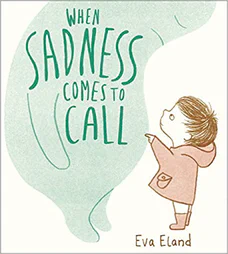When Sadness Comes to Call

Recommended Age Range: Preschool through elementary school. It’s simple on the surface but the message is profound.
Publisher's Summary:
When Sadness arrives, try not to be afraid: give it a name, listen to it and spend some time together. Maybe all it wants is to know that it’s welcome. This beautiful debut by new author-illustrator talent Eva Eland takes a poignant but uplifting look at dealing with uncomfortable emotions.

Dr. Annie's Takeaways
Recommended for: Really wonderful for a child impacted by a mood disorder or general feelings of sadness who is inclined to want to push away their feelings rather than attend to them with curiosity. For therapists, it’s a perfect introduction to the mindfulness
and acceptance components of Acceptance and Commitment Therapy (ACT)
. This book is available in many languages, including Spanish, Chinese, Dutch, Portuguese, and German.
Would a child like it? It’s not a riveting or funny book, but a child who struggles with sadness will likely really connect with this book and feel empowered by the change of perspective. This book is also likely to be as meaningful, if not moreso, for a parent and the way they relate to their child’s sadness.
Tone: soothing, peaceful, reassuring
Story Quality: This is a lovely story that portrays sadness as a sympathetic character who just wants to be heard and understood. Sadness enjoys drawing and walks in the woods and to know that it is welcome. It’s such a sweet, important message told in a beautiful, understated manner. It’s simple, but it quietly shifts the entire paradigm of how a child might relate to their sadness.
Illustrations: Beautiful, simple line drawings (in brown crayon) with splashes of color–Sadness is teal, other children are drawn with splashes of peach (a nod to this book’s companion Where Happiness Begins in which Happiness is peach-colored).
Representation: The child in the book has short hair but is not obviously gendered. Due to the (perhaps intentional) lack of detail in the drawings, the child’s race/ethnicity is not obvious either. This book is available in many languages, including Spanish, Chinese, Dutch, Portuguese, and German. There are two English-language titles which are exactly the same–it seems to be related to where they were published. The alternative English title is When Sadness Is at Your Door.
Psychological Practices: This book embodies the idea that none of our feelings are “bad” or dangerous–that all feelings are important and deserve our attention. It models a beautiful approach to externalizing sadness (i.e., thinking of it as something separate from a person rather than the person themselves): “Try not to be afraid of Sadness. Give it a name. Listen to it. Ask it where it came from and what it needs.” It very gently prompts behavioral activation
by suggesting that the child and Sadness may both enjoy activities such as drawing, listening to music, going outside, and taking a walk through the woods. It also encourages mindfulness
by suggesting that the child sit quietly with Sadness while they try to understand each other better, as well as suggesting that the child and Sadness may enjoy listening to the sounds of the trees as they walk through them. The book concludes with Sadness being gone when the child wakes up, following their day of spending time together. I like this reminder that sadness will not be here forever.
Concerns: None
